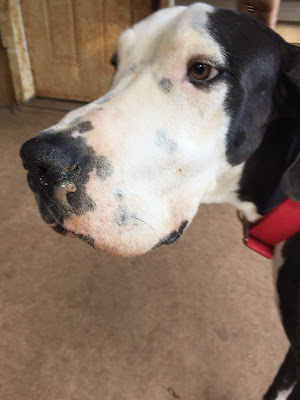| Image Credit:The Odyssey Online |
Once you find out the causes of the mischief, you will understand. Here are several reasons:
Marking of territory
If dogs want to own the place, they mark it. It is just like saying, “This place is my territory.” Even if it is your bed.
Smells just like pretty you
Dogs like to cover their scents by blending it with other odors. It helps them safe from predators. If she peed on your bed, she probably would hide her scent to blend on yours.
Anxiety
Dogs who are excited or anxious tend to pee. Your bed is a safe place for her. It has your scent. When she is scared, she hides on your bed. When she hears the thunder, she freaks out and pee!
Medical Reasons
Old dogs can’t hold their pee anymore and so does sick dogs. There is a sickness that makes a dog pee uncontrollably. One is Hormone Responsive Urinary Incontinence Syndrome that only affects females. It makes dog pee while sleeping not knowing about it at all.
There are certain medications also that affects dog bladders. Hence, dogs can’t avoid accidents.
| Image Credit: PetBookToday |
Is there a way to stop it?
- Make sure your dog feels safe while on your bed. If your dog sleeps with you, ensure that she is safe during thunderstorms or on times that she is scared. A little hug won’t harm.
- Seek Medications. If you notice frequent uncontrollable urination from your dog, seek advice from your vet. He is authorized to give your dog medicine for relief.
- Keep Your place clean.Clean your place all over. Make sure your bed is clean and fresh. Don’t let any urine odor be left. Clean sheets mean no more urine smell. As much as possible, no scent from you as well. Dogs usually pee again to the same place if they can still smell their scent.
| Image Credit: SheKnows: Pets and Animals Articles |
- Establish Restrictions. Don’t let your dog enter your room. Lock it all the time or install a gate. If she is used on sleeping with you, try giving her own bed. The best option is to make a dog house for her outside your room.
- Back to Crates. At times that you can’t watch out for your dog, it’s advisable to put him inside a cage. Reprimand her when she does her business anywhere. Let her know that peeing or pooping anywhere she likes is a big “NO.”
- Keep Your Dog Busy.Establish a schedule for your dog. Walk with her every morning. Hire a trainer to teach her certain tricks. Provide her with plenty of toys and engage her in some activities that will keep her busy.
- Let her socialize with other dogs. Do not give an opportunity for your dog to get bored.
| Image Credit: Cuteness.com |
Potty train her again. Learning is not an overnight sensation. Give your dog time to perfect her training. Do not forget to give her special treats every time she does good.
A good bonding with your dog will let you know her better. You will learn her favorite spots, toy and even fears. If you are close to your dogs, any sickness will be noticed and treated promptly. All unusual behaviors will be acted upon and will be resolved right away.
So try to create a close relationship with your dog!
About the Author:
My name is Ana. I have three lovely pups I love all my heart. I want to share experiences and tips for keeping your best puppy friends happy, healthy and well-behaved. Ana's website is Pup Tipper.







 .
.






































